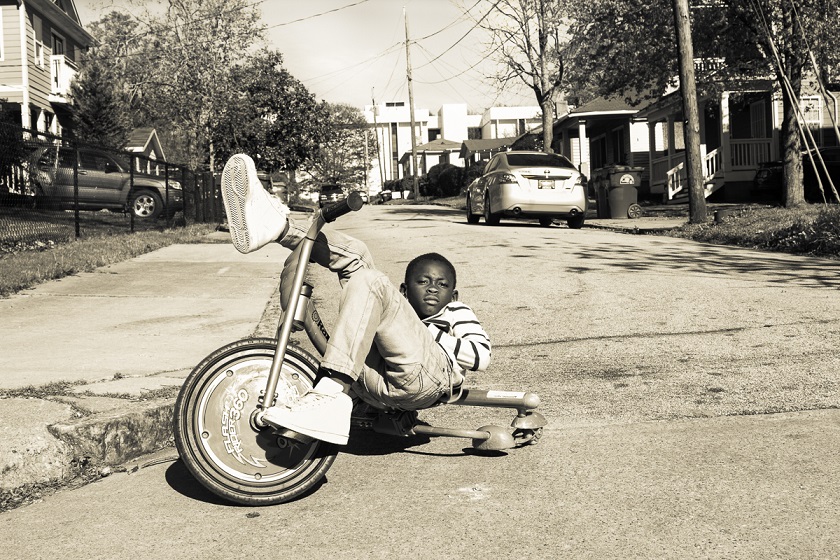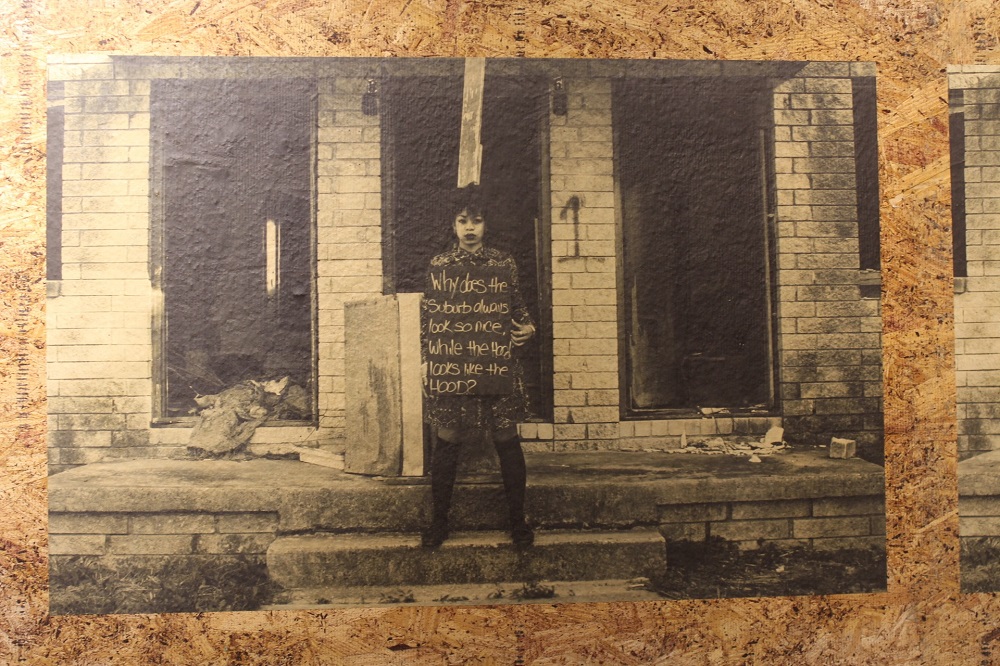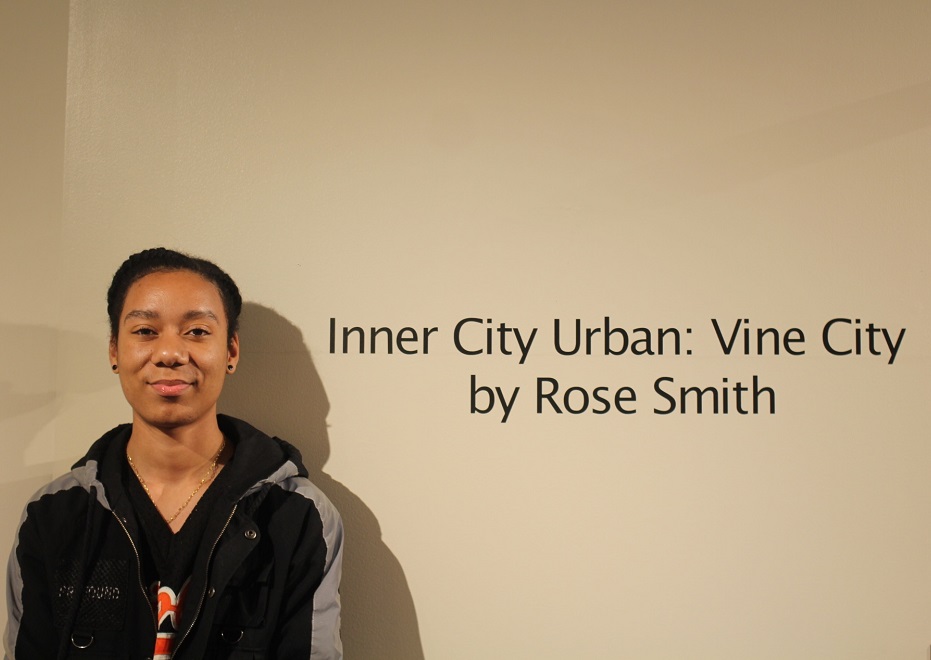Feature: Photographer Rose Smith Offers Glimpse into Vine City Through a Different Lens
Inner City Urban: Vine City, a photographic exhibition by Rose Smith, is currently on display at the Auburn Avenue Research Library.
The exhibition, which showcases visuals, voices and perspectives from Vine City residents, captures a narrative of a community working to hold onto the valuable culture they’ve built up in the face of impending change. We spoke with Smith about the exhibition to get some perspective from her on what it was like to create this body of work. Please see the Q&A below.
What’s your connection to Vine City and why was it important to make this work?
My connection with the Westside began with the West End. My cousins resided in the West End during my years of middle and high school, while my immediate family resided in Cherokee County, a rural part of north Georgia. I’d visit my cousins quite often and spend time in their neighborhood. Within that period of time, I felt as if I had missed out on an aspect of the Black experience; the lifestyle of growing up in the inner city. My interest in documenting the surrounding area arose out of what I felt I lacked.
I came across Vine City and English Avenue while researching low-income neighborhoods in Atlanta, and noticed the short distance between it and the West End. I drove there to see how it looked. Within that moment, I parked my car and got out to walk around to take in the neighborhood. I immediately became intrigued and instead of choosing to photograph the West End, where my cousins grew up, I chose Vine City, based solely on what I felt at the time. This was in April of 2015.
It was important for me to make this work initially to see the relation and connection in how residents of inner-city communities viewed home versus how I viewed home. I was on the quest to find if we had similar perspectives, which I found to be true. At that particular time, I noticed the construction project for the Mercedes-Benz Stadium and became concerned with if the completion of the stadium would affect residents of the Westside. My mission for creating this body of work shifted to capturing the current culture and livelihood of Vine City, which is more so about the people in the midst of seeing if this area would experience gentrification like other areas of Atlanta.
What specific story were you hoping to convey about Vine City and the residents of the community?
My narrative of Vine City is one that expresses truth and authenticity of the people and their home, a community that the residents value and holds historical significance. As all of the neighborhoods within close proximity of downtown are transforming, my mission is to create archival footage of this community even if it experiences the smallest portion of gentrification. Through this body of work, my goal is to raise the conversation of realistic affordable housing.

Talk about your material choices. What is the significance of the wood panels?
Although I am a documentary photographer, the display of my work is conceptual. The materials chosen for this project are newsprint and particle board/wood panels. I chose these materials while thinking about street art, newspaper covers, and what houses or vacant buildings are boarded up with. I chose to print my photographs on newsprint after thinking of each photograph as a cover of a newspaper while also considering that newsprint was also a paper used in street art with wheat-pasting signage. I chose to wheat-paste the prints on the wood as a non-conventional and non-archival way to display the work, which signified the abandonment of this community.

At the time, I had interviewed a longtime resident who expressed to me that she felt as if the city had overlooked Vine City for years, and she feared that the new stadium would cause her to move. Her story was also a major factor in why I chose this display. With this being a non-archival process, the work will transform over time, which equates to Vine City transforming over time.
This work is a part of a larger “Inner City Urban” series. What makes the Vine City story different from that of the Germantown community of Philadelphia? When did you know that Vine City was a community you wanted to feature?
“Inner City Urban” is a working series including all of Atlanta’s inner-city communities that are changing due to the growth and development of Atlanta. It also includes inner-city communities across the nation that are experiencing gentrification as well as inner city communities that have a much stronger foundation and are not allowing their communities to be redeveloped.
Germantown Philadelphia is a story that I recently began towards the end of 2017. In the midst of being there for such a short period of time, I spoke to a few residents about their community and their involvement with local government.
One gentleman mentioned that a few government officials reside within their community. And many of the residents work closely with these officials to make sure the community’s needs are met quickly. Also, there aren’t any major construction projects happening in Germantown that will attract tourists or a certain demographic causing transformation.
Vine City along with other low-income neighborhoods in Atlanta have community-based organizations where they discuss the needs and wants of the community, but the only difference I noticed is that despite their needs, the local government in Atlanta makes moves without much warning unless it’s the use of eminent domain; which is a sign of injustice. Vine City was the first community I chose when I began my Inner City Urban series in 2015.
How do you envision your role as a photographer/documentarian at this particular moment of your career?
My role as a documentarian is quite significant. I agree with Nina Simone – “An artist’s role in society is to reflect the time; it is our duty.” Gentrification “urban redevelopment” is a social justice issue, and as it is happening on a national and global level, it’s important that I provide a voice for the people being affected so that we are able to hold our government accountable. This is supposed to be the “Land of the Free and the Home of the Brave,” but those words lose meaning when adequate housing is not provided, and the history we’ve established within our communities is erased and replaced with the unfamiliar.
How important was it to have the work on display at the Auburn Research Library?
My connection with the Auburn Research Library was made shortly after my work was installed for public engagement throughout downtown last year.
Watch video of Smith’s downtown installation.
It was important for me to have this work exhibited at the library considering that it’s a library of African-American history and Atlanta’s African-American history. It was also important because of my topic and primary focus in relation to Atlanta’s African-American neighborhoods and the current news.
How long did it take you to complete the work, and do you have a favorite story or person from the work?
I completed this work within three years; however, I still find myself photographing Vine City and English Avenue quite often although I have moved on to photograph another neighborhood. It’s just something about its presence that’s unforgettable. One of my favorite photographs is actually not on display in this exhibit due to a limited number of pieces for the size of the space.
The title of my favorite photograph is Irwin Street. I interviewed and photographed a young man and his little cousin standing on the porch of their home. He didn’t live in Vine City but his grandmother and little cousin reside there. He visits quite often and brings over groceries while keeping his cousin entertained on the weekends. He expressed that this keeps him out of trouble. His story resonated with me because it made me think about the simple/smallest things are typically what impact our lives the most.
What is the lasting message or perspective you want viewers to take away from this work?
I’d like viewers to remember the faces of the people of Vine City and their neighborhood if it transforms while the city of Atlanta grows and transforms. I want people to think about their communities and what home means to them and what type of trauma would be caused if their communities were on the verge of redevelopment.
Inner City Urban: Vine City is on display from March 12 – April 29. The exhibit is free and open to the public. Smith will return to the library for a closing artist talk at 3 p.m. on Sunday, April 29.

About Rose Smith: Rose Smith is a conceptual documentary photographer currently residing in Atlanta, Georgia. A native of Memphis, Tennessee, Smith began her artistic practice at the age of 10 after discovering an interest in the medium of photography while watching her father create VHS tapes and make photographic documentary stills with Polaroids.
She received her BFA in Photography at the Savannah College of Art and Design where she studied and became inspired by the works of Gordon Parks, Roy DeCarava, Baldwin Lee, Lorna Simpson, and Carrie Mae Weems; all of whom created photographic narratives on the Black experience in the U.S.
Similar to them, Rose uses the medium of photography for activism to discuss social issues that reflect the present time and continue to affect people of color. She exhibits her commitment to photography by educating and expounding on topics that are often overlooked.
